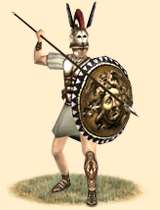Triarii (Camillan Roman Hoplite Maniple)
 |
Weapons | Defence | Mental | ||||||
|---|---|---|---|---|---|---|---|---|---|
| Primary | Secondary | Armour: | 14 | Morale: | 14 | ||||
| Type: | spear | none | Shield: | 4 | Discipline: | disciplined | |||
| Attack: | 15 | 0 | Skill: | 9 | Training: | highly_trained | |||
| Charge: | 8 | 0 | Recruitment | Other | |||||
| Lethality: | 0.13 | 0.1 | Soldiers: | 40 | Hit Points: | 1 | |||
| Range: | 0 | 0 | Cost: | 1623 | Mass: | 1.22 | |||
| Ammo: | 0 | 0 | Upkeep: | 406 | |||||
| Turns: | 1 | ||||||||

The triarii are the oldest but also most experienced soldiers of a legion and forming the third and last line. They fight with long hasta spears in phalanx formation, better suited to stop the enemy and stabilize the line if all hope rest on them.
As all citizens soldiers Triarii can be recruited in the central Italian provinces Latium, Umbria, Etruria, Apulia, Liguria and Campania. These are the heartlands of the Res Publica, filled with our colonies founded during the epic struggles of the past centuries.
The Triarii are the oldest and most experienced soldiers of a legion, and form the third line of heavy infantry. Most often during battle they are kept in reserve, resting on one knee under cover of their shields to stay fresh and protected until they are needed. They are the rock of the legion, covering a "rearward advance" if the heavy infantry assault failed, and an old Roman adage came of their use: "to have come to the Triarii" meant that the situation was dire, indeed.
The Triarii are still equipped in full Greek panoply. They wear a muscled cuirass, a bronze greave on the leading leg, an Etrusco-Corinthian helmet, carry a Greek Clipeus shield, a hoplite sword, and the hasta thrusting spear.Thus, the Triarii still continue to fight like the classical hoplite of the 5th and 4th century BC Etruscan Roman armies. After the Hastati and Principes have retreated through their line, they will form a single massive block and fight in phalanx formation, more suited to stop the enemy and stabilize the line when all hope rest on them.
Historically, the legion advanced in the famous, chessboard like, quinqunx formation. Three lines of heavy infantry with broad gaps between the single manipuli covered by the next line's displaced marching units. This practice gave the Roman army a higher maneuverability on the battlefield and made it less dependant upon the terrain than the Greek phalanx. During the battle the gaps allowed beaten or retreating units as well as fresh troops to move through the lines.
The roman infantry of the late 4th and early 3rd century BC was divided by wealth in two groups. Those with the lowest property classification for military service were fighting as light infantry, separated by fighting ability into the Leves, Rorarii and Accensi. The second, more wealthy group consisted of those fighting as heavy infantry, separated by their age and fighting ability into Hastati, Principes, and Triarii.
Every male roman had the duty to serve in the infantry for 16 years, or 20 years in the case of national emergency, until he had completed his 46th year of life. Excepting those rated high enough by the censor to be members of the ordo equester. Normally every roman must have served at least ten years in the military before he was permitted to hold any political office.